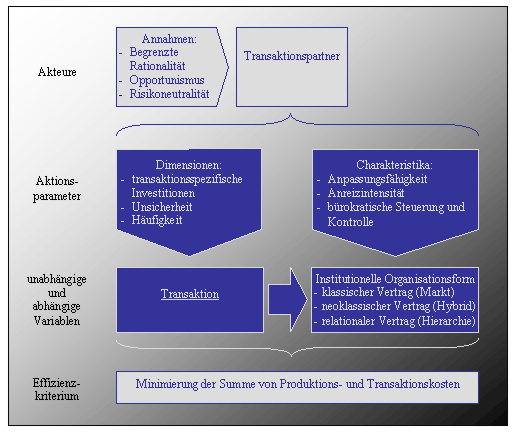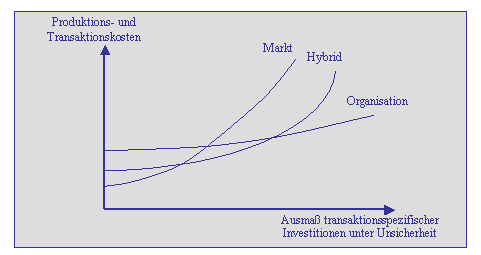After the basic model of the transaction cost theory a given transaction under the behavior acceptance
mentioned can be organized and completed the more efficiently, the correspond themselves better the characteristics
of the institutional arrangement the requirements resulting in from the dimensions of the transaction which can be completed.
55
Illustration 3 illustrates that the transaction cost theory underlying basic model.

Fig. 3: Basic model of the transaction cost theory 56
From the connection between independent and dependent variables the main statement of the transaction cost theory results: The market represents the most favourable organization form due to its strong incentives and the effectiveness of the competition mechanism, which opportunistic behavior makes limited and economical autonomous adjustment processes possible, if transactions are not connected with special uncertainty or transaction specific investments. 57
With increasing transaction specific investments and increasing uncertainty first long-term, contingents of contracts with
safeguards become favourable.
With very high extent of transaction specific investments the organization-internal achievement
production is preferred.
"heavy and more expensively it per will to consider all circumstances of the exchange relationship in
neoclassical contracts and the more largely the potential profits are the more attractive, which could obtain the transaction
partners due to uncertainty and transaction specific investments from opportunistischem behavior, will it to provide the property
or the achievement organization-internally.
In particular with large uncertainty and high transaction specific investments
the organization-internal achievement production represents the relatively most favorable institutional arrangement."
58
The following illustration illustrates the cost process of the three institutional
arrangements as a function of the extent of transaction specific investments under uncertainty.59

Fig. 4: Cost process of the different institutional arrangements as a function of
Measured transaction specific investments under uncertainty. 60
55 Vgl. Ebers/Gotsch (1995), P. 218.
56 ajar on: Ebers/Gotsch (1995), P. 219.
57 Vgl. Shelanski/Klein (1995), P. 337.
58 Ebers/Gotsch (1995), P. 222 FF.
59 Vgl. Williamson (1991), P. 284.
60 Vgl. Williamson (1991), P. 284.


